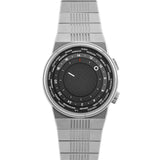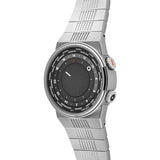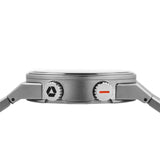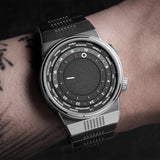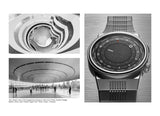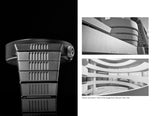BOLD MINIMALISM
The dial consists of four concentric circles: the innermost dial tracks minutes; the next tracks hours and the following displays the 24-hour time with a day/night indicator. The outermost disk features 24 cities that allow wearers to easily track each timezone. Instead of traditional hands that mark the passing of time, printed graphic elements are instead employed to maintain visual cleanliness. The resulting abundance of negative space wonderfully showcases the textured dial, which dances between an understated grain in the shadow and elegantly exuberant speckles under direct light.


Architectural Influence
The architecturally-minded will draw a line from the concentric motifs on the watch to the tiered structure of New York's Guggenheim Museum, the sculptural masterpiece by American architect Frank Lloyd Wright. An icon of American design, Wright's blueprints for the museum served as a key reference for the Alterum Worldtimer, from the multi-ringed dial to the grooved bracelet links that mirror the interior and exterior experiences of the Guggenheim.
American Design, Swiss Made
To help bring his vision to life, founder Justin Walters partnered with the Swiss specialist manufacturer, Roventa-Henex. Even if the name is unfamiliar, chances are you’ve tried on or even owned one of the watches they manufacture. They are Switzerland’s most renowned 'white label' watch factory and manufacture timepieces for some of the biggest brands in the industry. The resulting tactility of the Worldtimer — from the engaging jumps on the city disk to its supple articulating links — stands up to the most discerning collector.


Customized Calibre
Powering the Worldtimer is the SW330-2, a well-loved GMT varient of Sellita's workhorse that has been further customized by Roventa-Henex. Gone is the superflous date wheel and central seconds; the GMT module is modified to display a 24 city disk on the outermost ring, instead of a central GMT hand.

